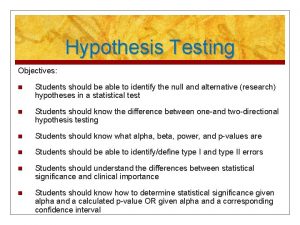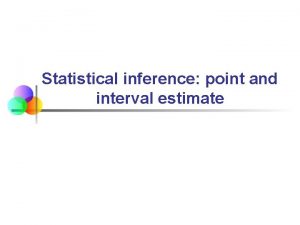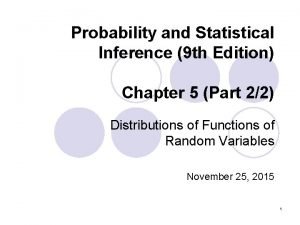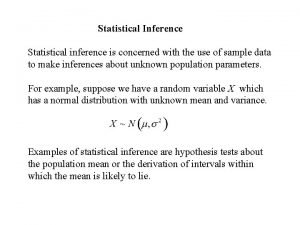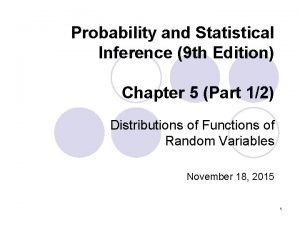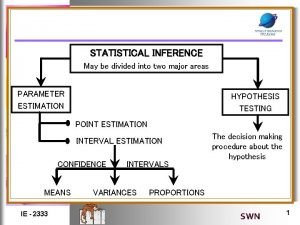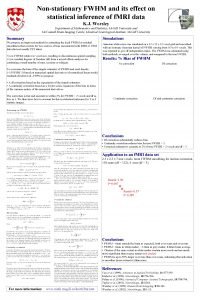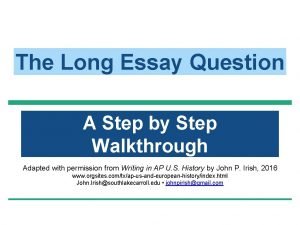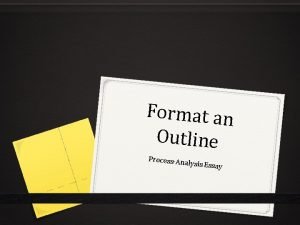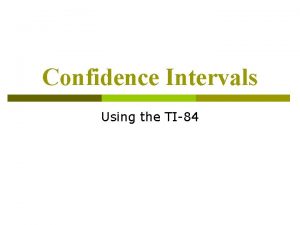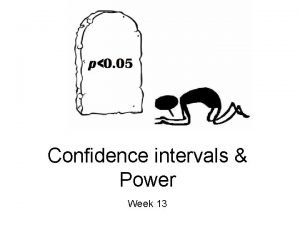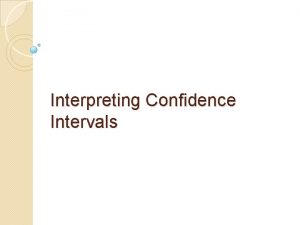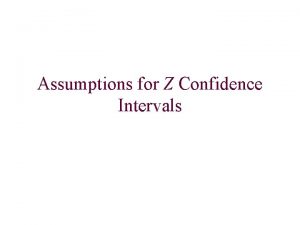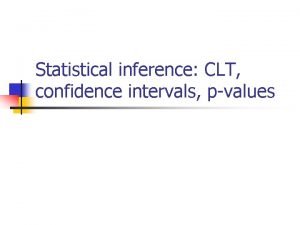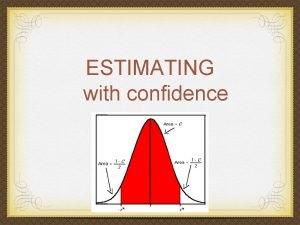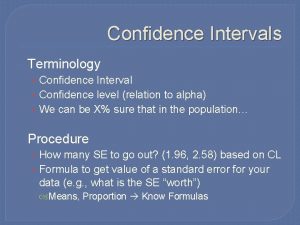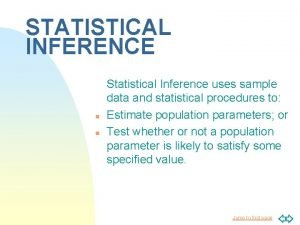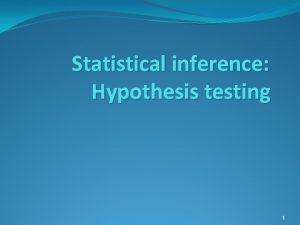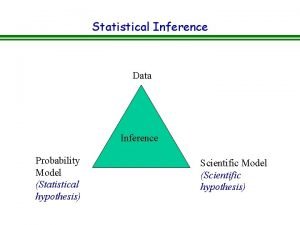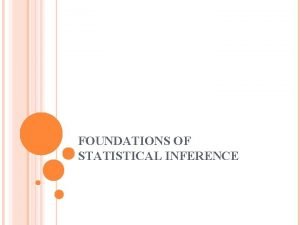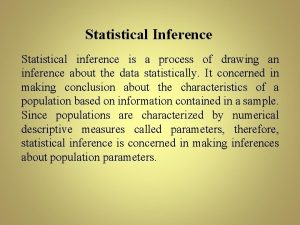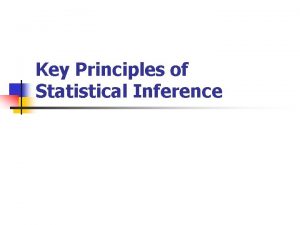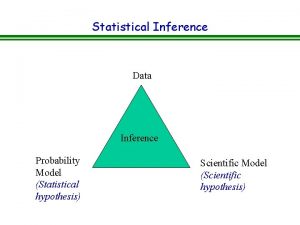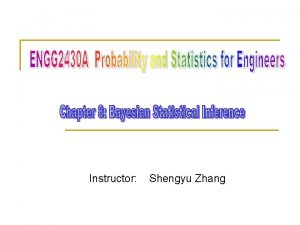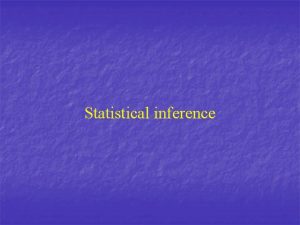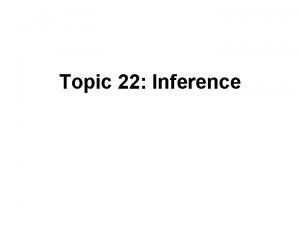Topic 4 Statistical Inference Outline Statistical inference confidence























- Slides: 23

Topic 4: Statistical Inference

Outline • Statistical inference – confidence intervals – significance tests • Statistical inference for β 1 • Statistical inference for β 0 • Tower of Pisa example

Theory for Statistical Inference • Xi iid Normal(μ, σ2), parameters unknown

Theory for Statistical Inference • Consider variable • t is distributed as t(n-1) • Use distribution in inference for m – confidence intervals – significance tests

Confidence Intervals where tc= t(1 -α/2, n-1), the upper (1 -a/2)100 percentile of the t distribution with n-1 degrees of freedom • 1 -a is the confidence level

Confidence Intervals • is the sample mean (center of interval) • s( ) is the estimated standard deviation of , sometimes called the standard error of the mean • is the margin of error and describes the precision of the estimate

Confidence Intervals • Procedure such that (1 -a)100% of the time, the true mean will be contained in interval • Do not know whether a single interval is one that contains the mean or not • Confidence describes “long-run” behavior of procedure • If data non-Normal, procedure only approximate (central limit theorem)

Significance tests

Significance tests • • • Under H 0 t* will have distribution t(n-1) P(reject H 0 | H 0 true) = a (Type I error) Under Ha, t* will have noncentral t(n-1) dists P(DNR H 0 | Ha true) = b (Type II error) Type II error related to the power of the test

NOTE IN THIS COURSE USE α=. 05 UNLESS SPECIFIED OTHERWISE

Theory for β 1 Inference

Confidence Interval for β 1 b 1 ± tcs(b 1) where tc = t(1 -α/2, n-2), the upper (1 -α/2)100 percentile of the t distribution with n-2 degrees of freedom • 1 -α is the confidence level

Significance tests for β 1

Theory for β 0 Inference

Confidence Interval for β 0 b 0 ± tcs(b 0) where tc = t(1 -α/2, n-2), the upper (1 -α/2)100 percentile of the t distribution with n-2 degrees of freedom • 1 -α is the confidence level

Significance tests for β 0

Notes • The normality of b 0 and b 1 follows from the fact that each of these is a linear combination of the Yi, each of which is an independent normal • For b 1 see KNNL p 42 • For b 0 try this as an exercise

Notes • Usually the CI and significance test for β 0 is not of interest • If the ei are not normal but are relatively symmetric, then the CIs and significance tests are reasonable approximations

Notes • These procedures can easily be modified to produce one-sided confidence intervals and significance tests • Because we can make this quantity small by making large.

SAS Proc Reg proc reg data=a 1; model lean=year/clb; run; clb option generates confidence intervals

Variable Intercept year Parameter Estimates Parameter Standard 95% Confidence DF Estimate Error t Value Pr > |t| Limits 1 -61. 12088 25. 12982 -2. 43 0. 0333 -116. 43124 -5. 81052 1 9. 31868 0. 30991 30. 07 <. 0001 8. 63656 10. 00080 CIs given here…. CI for intercept is uninteresting

Review • What is the default value of α that we will use in this class? • What is the default confidence level that we use in this class? • Suppose you could choose the X’s. How would you choose them if you wanted a precise estimate of the slope? intercept? both?

Background Reading • Chapter 2 – 2. 3 : Considerations • Chapter 16 – 16. 10 : Planning sample sizes with power • Appendix A. 6
 Quotation sandwich example
Quotation sandwich example Confidence interval vs confidence level
Confidence interval vs confidence level Confidence interval vs confidence level
Confidence interval vs confidence level Statistical inference point estimation
Statistical inference point estimation Proof of chebyshev's inequality
Proof of chebyshev's inequality Statistical inference is concerned with
Statistical inference is concerned with Probability and statistical inference 9th solution pdf
Probability and statistical inference 9th solution pdf Statistical inference is divided into
Statistical inference is divided into Statistical inference
Statistical inference Example of clincher sentence
Example of clincher sentence Narrow down the topic
Narrow down the topic Dbq thesis formula
Dbq thesis formula Digital topic outline
Digital topic outline Sentence outline
Sentence outline S
S A topic outline uses
A topic outline uses Judybats
Judybats How to do confidence intervals on ti 84
How to do confidence intervals on ti 84 Weed and confidence
Weed and confidence Originality is related to which confidence plank?
Originality is related to which confidence plank? How to report a confidence interval
How to report a confidence interval 96 percent confidence interval
96 percent confidence interval Assumption for confidence interval
Assumption for confidence interval Conviction vs confidence
Conviction vs confidence


